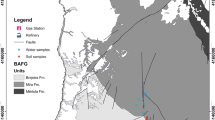Abstract
An oil-impacted site at Oshire-2 in Niger Delta (Nigeria) was delimited by reconnaissance. Surface and subsurface soils were analyzed for total extractable hydrocarbon content and some physicochemical characteristics. The oil-impacted soils had a mean hydrocarbon content of 1.99 × 103 mg/kg (no overlap in Standard Error at 95% Confidence Limit) and were characterized by an isohyperthermic temperature regime >22°C, high moisture content, high acidity (low soil-pH) and low electrical conductivity. The intense infusion of degradable hydrocarbons at the site must have stimulated aerobic and anaerobic microbial metabolism and so, as oxygen became limiting, utilization of alternate electron acceptors produced an increasingly reducing environment.
Similar content being viewed by others
References
Amadi, A., Dickson, A., & Maate, G. O. (1993). Remediation of oil polluted soils: 1.Effect of Organic and inorganic nutrient supplements on the performance of maize (Zea may L.). Water, Air, and Soil Pollution, 66, 59–76.
Atlas, R. M., & Bartha, R. (1997). Microbial ecology fundamentals and principles, benjamin/cummings science publishing Co. 985 pp.
Benka-Coker, M. O., & Ekundayo, J. A. (1995). Effects of an oil spill on soil pysico-chemical properties of a spill site in the Niger delta area of Nigeria. Environmental Monitoring and Assessment, 36, 93–104.
Dibble J. T., & Bartha, R. (1981). Effects of environmental parameters on the biodegradation of an oil sludge. Applied and Environmental Microbiology, 37, 729–739.
DPR (1991). Environmental Guidelines and Standards for the Petroleum Industry in Nigeria, Department of Petroleum Resources, Ministry of Petroleum and Mineral Resources, Lagos, 172 pp.
Ekundayo, E. O., & Obuekwe, C. O. (1997). Effects of an oil spill on soil physico-chemical properties of a spill site in a typic paleudult of midwestern Nigeria. Environmental Monitoring Assessment, 45, 209–221.
HSE-ENV (2004). Accompanying Guidelines for SPDC EIA Process. SPDC-0002712, Vol. 3. Shell Petroleum Development Company of Nigeria, 17 pp.
Manahan, S. E. (1994). Environmental chemistry. Boca Raton, FL: CRC Press, 811 pp.
NDES (1999). The Niger Delta Environmental Survey Phase 1 Report, Vol. 1 Environ-mental and Socio-Economic Characteristics’ in Technical Report Submitted by Environ-mental Resource Managers Ltd, Lagos, pp. 22–34.
Nwankwo J. N., & Ifeadi, C. N. (1988). Case studies in the environmental impact of oil production, marketing in Nigeria. In P. O. Sada, & F. O. Odemerho (Eds.), Environmental issues and management in Nigeria (pp. 208–228). Ibadan: Evans Brothers Nigeria Limited.
Odum, E. P. (1971). Fundamentals of ecology. Philadelphia: W. B. Saunders Company 574 pp.
Okpokwasili, G. C., & Amanchukwu, S. C. (1988). Petroleum hydrocarbon degradation by Candida species. Environment International, 41, 234–247.
Osuji, L. C. (2001). Total hydrocarbon content of soils, fifteen months after Eneka and Isiokpo oil spills. Journal of Applied Science Environment Management, 5(2), 35–38.
Osuji, L. C., Adesiyan, S. O., & Obute, G. C. (2004). Post impact assessment of oil pollution in Agbada-west plain of Niger delta: Field reconnaissance and total extractable hydrocarbon content. Chemistry & Biodiversity, 1, 1569–1578.
Osuji, L. C., & Onojake, C. M. (2004). Trace heavy metals associated with crude oil: A case study of Ebocha-8 oil-spill-polluted site in Niger delta, Nigeria. Chemistry & Biodiversity, 1, 1708–1715.
Osuji, L. C., & Adesiyan, S. O. (2005). The Isiokpo oil-pipeline leakage: total organic carbon/organic matter contents of affected soils. Chemistry & Biodiversity, 2, 1079–1085.
Osuji, L. C., Egbuson, E. J., & Ojinnaka, C. M. (2005). Chemical reclamation of crude- oil-inundated soils from Niger Delta, Nigeria. Chemistry and Ecology, 21(1), 1–10.
Acknowledgements
The authors wish to thank the Management of Nigerian Agip Oil Company (NAOC) Port Harcourt and he Department of Petroleum Resources (DPR) for facilitating the field program.
Author information
Authors and Affiliations
Corresponding author
Rights and permissions
About this article
Cite this article
Osuji, L.C., Opiah, U.C. Hydrocarbon contamination of a terrestrial ecosystem: the case of Oshire-2 oil spill in Niger Delta, Nigeria. Environmentalist 27, 337–340 (2007). https://doi.org/10.1007/s10669-007-9034-7
Published:
Issue Date:
DOI: https://doi.org/10.1007/s10669-007-9034-7



